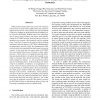Free Online Productivity Tools
i2Speak
i2Symbol
i2OCR
iTex2Img
iWeb2Print
iWeb2Shot
i2Type
iPdf2Split
iPdf2Merge
i2Bopomofo
i2Arabic
i2Style
i2Image
i2PDF
iLatex2Rtf
Sci2ools
123
Voted
ICDCS
2007
IEEE
2007
IEEE
Protocol Design and Optimization for Delay/Fault-Tolerant Mobile Sensor Networks
While extensive studies have been carried out in the past several years for many sensor applications, they cannot be applied to the network with extremely low and intermittent connectivity, dubbed the Delay/Fault-Tolerant Mobile Sensor Network (DFT-MSN). Without end-to-end connections due to sparse network density and sensor node mobility, routing in DFT-MSN becomes localized and ties closely to medium access control, which naturally calls for merging Layer 3 and Layer 2 protocols in order to reduce overhead and improve network efficiency. DFT-MSN is fundamentally an opportunistic network, where the communication links exist only with certain probabilities and become the scarcest resource. At the same time, the sensor nodes in DFT-MSN have very limited battery power like those in other sensor networks. Clearly, there is a tradeoff between link utilization and energy efficiency. To address this tradeoff, we develop a cross-layer data delivery protocol for DFT-MSN, which includes two ...
Related Content
| Added | 03 Jun 2010 |
| Updated | 03 Jun 2010 |
| Type | Conference |
| Year | 2007 |
| Where | ICDCS |
| Authors | Yu Wang, Hongyi Wu, Feng Lin, Nian-Feng Tzeng |
Comments (0)

